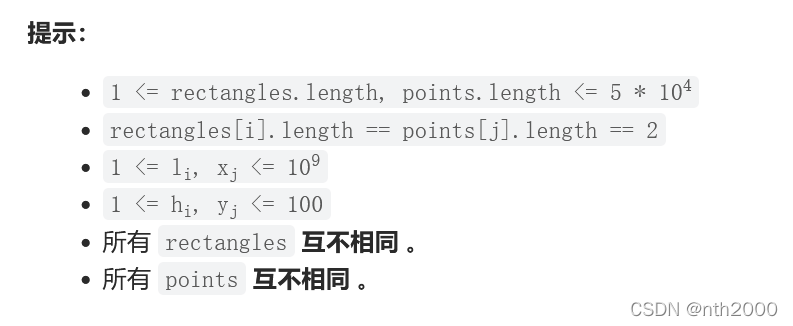T3 统计包含每个点的矩形数目


- 注意数据范围。纵坐标取值空间较小
- 故在纵坐标维度上,对每个相同的纵坐标的横坐标进行排序。
- 而不是反过来
class Solution {
public:
vector<int> countRectangles(vector<vector<int>>& rectangles, vector<vector<int>>& points) {
vector<int> df[101];
for(vector<int> a : rectangles)
{
df[a[1]].push_back(a[0]);
}
for(int i = 0;i<101;i++) sort(df[i].begin(),df[i].end());
vector<int> count;
for(vector<int> p : points)
{
int tmp = 0;
for(int i = p[1];i<101;i++)
{
tmp += df[i].end() - lower_bound(df[i].begin(),df[i].end(),p[0]);
}
count.push_back(tmp);
}
return count;
}
};
T4花期内花的数目


- 一来就想到线段树。给每个区间加上1.但是区间取值空间太大,线段树维护存不下
- 特殊:区间个数较少,且每次区间都加的是1,而不是其他数。
- 因此对给定的数字,搜索在其前面开花的区间,并搜索在其前面凋谢的区间。
class Solution {
public:
vector<int> fullBloomFlowers(vector<vector<int>>& flowers, vector<int>& persons) {
vector<int> st;
vector<int> end;
for(vector<int> a:flowers)
{
st.push_back(a[0]);
end.push_back(a[1]);
}
sort(st.begin(),st.end());
sort(end.begin(),end.end());
vector<int> ans;
for(int v : persons)
{
auto i = upper_bound(st.begin(),st.end(),v);
auto j = upper_bound(end.begin(),end.end(),v);
ans.push_back(i - st.begin() - (j - end.begin()));
}
return ans;
}
};
- 另:比赛中反应出的C++问题
- set迭代器不能用于计数
- 自定义排序函数的写法可以是
sort(rectangles.begin(), rectangles.end(), [](auto &a, auto &b) { return a[1] > b[1]; });
- 注意变遍历为引用,可以节省复杂度:
例如超时代码:
for(vector<int> c : circles)
{
int x1 = c[0];
int y1 = c[1];
int r = c[2];
if((x1 - x)*(x1 - x) + (y1 - y) * (y1 - y) <= r*r)
{
flag = true;
break;
}
}
在vector之前加引用以后,不超时了:
class Solution {
public:
int countLatticePoints(vector<vector<int>>& circles) {
int ans = 0;
for(int x = 0;x<=200;x++)
{
for(int y = 0;y<=200;y++)
{
bool flag = false;
for(vector<int>& c : circles)
{
int x1 = c[0];
int y1 = c[1];
int r = c[2];
if((x1 - x)*(x1 - x) + (y1 - y) * (y1 - y) <= r*r)
{
flag = true;
break;
}
}
ans += flag;
}
}
return ans;
}
};
